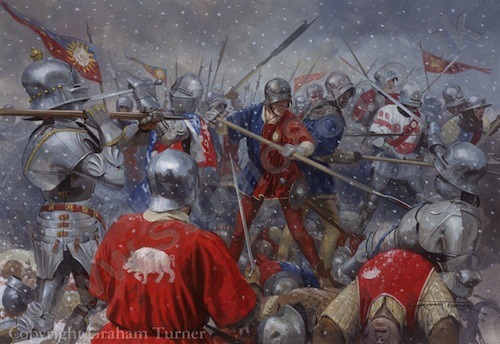edwardslovelyelizabeth:On this day in he Wars of the Roses history, 29th of March 1461 - the Battle
edwardslovelyelizabeth:On this day in he Wars of the Roses history, 29th of March 1461 - the Battle of Towton. It was the decisive battle of the first phase of the Wars of the Roses and saw the young Edward IV defeat one of the largest Lancastrian armies to take to the field during the war. This victory came only four weeks after Edward had claimed the throne, and helped establish him as the accepted king of England.On the morning of 29 March it was clear that both sides wanted a battle. Both had raised sizable armies and both clearly believed that a battlefield victory would end the war in their favour.We only have limited information about the two side’s deployment at the start of the battle. According the Waurin the Lancastrians posted a force of cavalry, in Castle Hill Wood, on the western side of the battlefield, forming the Lancastrian right flank. They were hidden here and waited for a chance to ambush Edward’s men. Somerset commanded the main part of the army, while the earl of Northumberland was probably in the east, forming the left flank. Exeter and Lord Wilton commanded the rearguard.Edward’s vanguard was commanded by Lord Fauconberg and contained a fore of archers. Edward himself and Warwick were probably in the central part of the line.The battle began with one of its most famous incidents. According to Hall’s Chronicle Lord Fauconberg took advantage of the southerly wind. He ordered his archers to fire a single flight. These arrows hit the Lancastrian archers, who responded with rapid fire. Unfortunately the snow and wind meant that their arrows fell short. Once they had run out of arrows Fauconberg ordered his men to advance a few steps and open fire. They then opened fire at a more effective range, using their own arrows and half of the Lancastrian arrows. The rest were left in the ground to act as an obstacle. This is a dramatic story but it may be an exaggerated version of a more contemporary mention of a southerly wind that made things harder for the Lancastrian archers.Fauconberg’s archery attack seems to have provoked a general Lancastrian advance, although they may have always intended to try and take advantage of their superior numbers. Somerset and Earl Rivers led this attack, and the Yorkist left was pushed back. Northumberland advanced more slowly, and was wounded and forced to withdraw from the fight.At this point Waurin records a surprise attack by the cavalry hidden in Castle Hill Woods. The Yorkist left was pushed back, and Edward’s cavalry may have been forced off the battlefield.The battle now settled down into a hard fought melee, possible with the battle lines now rotated by 45 degrees anti-clockwise. The Yorkist line was under severe pressure and Edward’s own personal prowess was said to have played a major part in preventing his army from breaking. Contemporary sources suggest that Edward was close to defeat at this stage in the battle.The situation was changed by the arrival of Yorkist reinforcements. The Duke of Norfolk’s men arrived along the Ferrybridge Road, placing them on the Yorkist right and Lancastrian left. The Duke himself may not have reached the battlefield - he was a sick man and died within a year - but his fresh troops were enough to turn the tide. The Lancastrian line began to give way.At about this point Somerset made his escape, and as their leaders attempted to reach safety the Lancastrian line crumbled. Their early successes in the west now turned against them. As they fled back from the fighting many became trapped in a loop in Cock Beck, in the area that is now known as Bloody Meadow. The Yorkist pursuit was brutal, although Edward himself probably didn’t take part. The surviving Lancastrians were only safe when they reached York.Most contemporary sources state that the heralds counted twenty-eight thousand dead after the battle. The Neville chronicler gives a lower figure of 9,000. The number of senior Lancastrians to fall suggests that the casualty figures were indeed high, although given that we can’t be sure how large either army was any attempt to estimate casualty figures is fairly futile. Unusually for a medieval battle the graves of many casualties have been found, providing a valuable insight into the nature of military service during this period - some of the dead had survived surprisingly serious wounds that had long-healed by the time they were killed at Towton.Many of the Lancastrian leaders were killed. Henry Percy, earl of Northumberland, was the most important casualty on the field, but Lords Dacre, Neville, Clifford, Wells, Willoughby and Mauley and Sir Andrew Trollope were also amongst the dead. The earls of Wiltshire and Devon were both captured and executed after the battle.The only blot on Edward’s victory was his failure to capture the Lancastrian royal family. Henry, Margaret and Prince Edward managed to reach Scotland, taking with them Somerset, Exeter and Lords Hungerford and Roos as well as Chief Justice Fortescue. As a result the Lancastrians were able to keep their cause alive, at least in the far north, and it would take another three years of campaigning before the fighting died down.In the aftermath of his victory Edward entered York, where one of his first actions was to have the heads of his father, brother and Salisbury taken down and buried properly.A number of his supporters were rewarded with new titles after the battle. His brother George became Duke of Clarence. His uncle, Viscount Bourchier, was made Earl of Essex. Lord Fauconberg became Earl of Kent. A number of knights were promoted to the peerage, amongst them the new Lords Devereux, Herbert and Wenlock.The battle of Towton didn’t end the fighting in the first phase of the Wars of the Roses, but it did make a Lancastrian victory almost impossible. -- source link
Tumblr Blog : edwardslovelyelizabeth.tumblr.com
#history#edward iv#kings
